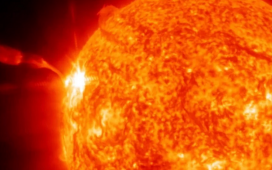This week, we track down another prominent constellation in the northern hemisphere’s spring night sky: Boötes, the herdsman. Listed as part of the 48 constellations described by Ptolemy in the 2nd century, it is now one of the International Astronomical Union’s 88 official constellations.
Although known as the herdsman, some stories associated with the constellation depict him as more of a ploughman, driving the constellation of Ursa Major, the great bear, around the pole. In these stories, Ursa Major is changed into an oxen and plough.
The nearby constellation of Canes Venatici, the hunting dogs, is also said to be associated with Boötes. On many old star maps, he is depicted as holding these dogs on a leash.
The chart shows the view looking south-east from London at 22.00BST on 19 May, although the view will remain essentially unchanged all week.
The brightest star in Boötes is the red giant star Arcturus, which is the fourth brightest star in the night sky. Although it has about the same mass as our sun, it has swollen to 25 times its size and now pumps out around 170 times more light.
Boötes is also visible from the southern hemisphere, where it will appear quite close to the northern horizon.










